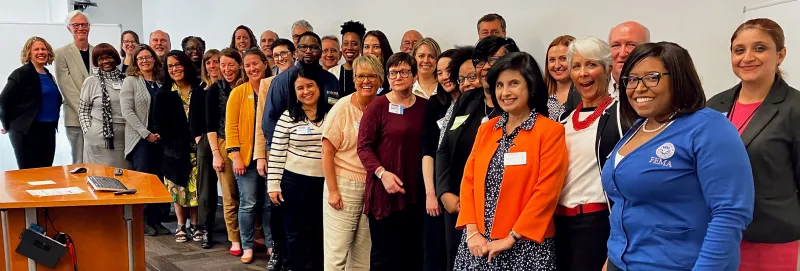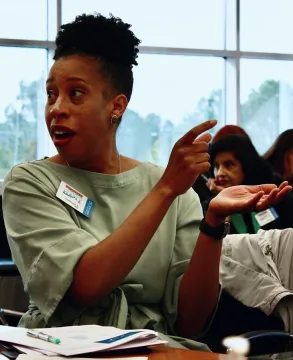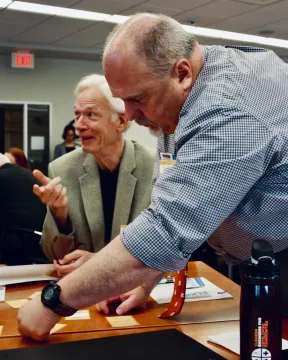The Science and Technology Directorate (S&T) and a Department of Homeland Security (DHS) Center of Excellence are researching ways to enhance disaster resilience in socially vulnerable communities.
The 2023 hurricane season was one of the more severe on record, according to the National Oceanic and Atmospheric Administration (NOAA). Academic and disaster resilience communities have documented empirically that disenfranchised communities are disproportionately impacted by these severe weather events. With NOAA predicting increasing impacts of hurricanes in the future, S&T is trying to identify ways to help fortify marginalized communities against this impending risk.
According to Dr. David Alexander, senior science advisor for resilience at S&T, since 1980, there have been more than 377 billion-dollar disasters, based on NOAA statistics. These are disasters that resulted in $1 billion dollars or more in damages and losses each. More significantly, these disasters have amounted to more than 16,000 fatalities.
“People are losing their lives, not just their homes and businesses,” Alexander said. “If you look at the resilience research, there is a common theme, and it is well-recognized that underserved communities are disproportionately affected and experience more disaster suffering.”
While many in the federal government seek to foster greater equity for marginalized communities during disasters, S&T is investing in tools and technologies to inform policy and support this mission.

This was the purpose of a recent Coastal Resilience Center (CRC) Disasters and Equity Workshop that brought together community leaders, practitioners, and researchers to discuss best practices for reducing risk throughout the disaster lifecycle (mitigation, preparedness, response, and recovery) in an equitable way. The CRC is a nationwide consortium led by the University of North Carolina at Chapel Hill conducting research to increase the resilience of people, infrastructure, economies, and the natural environment from coastal hazards.
“Our challenges have become more complex. Therefore, we need to ensure that we’re leveraging diversity of opinion, experience, and knowledge and really try to bring our communities, as well as practitioners and academics, together, and invite the private sector to partner with us so we can scale out solutions and deliver a broader impact to the nation,” Alexander said.
“The focus, using a science and technology lens, is recognizing a desire to push the envelope on participatory research,” he continued. “It’s about driving co-development of solutions to fill critical gaps in individual and community preparedness and developing solutions that help us to eliminate inequities in disaster resilience. The goal is to better link scientific experts and cutting-edge solutions to community partners and help them avoid disaster fatigue.”
S&T and CRC first studied existing planning frameworks underpinning disaster equity planning. They then studied what kind of data would be required to support more equitable planning. With an understanding of the policy and data, this workshop was a next step in contextualizing this research with evidence from front-line responders. The goal was to have participants help answer questions like: How can we achieve better outcomes after disasters strike and ensure those positive outcomes extend to all communities? What policies are in place and are they working? What do individual communities view as their critical needs and challenges? Are we investing in the right science and technology to close those gaps and support all segments and all geographies?
“The [CRC], eight or nine years ago, started pushing us hard and saying, 'You’ve got to be grounded,’” says Dr. Phil Berke, one of CRC’s researchers. “Put boots on the ground and translate all this great research into action."

Dr. Thomas John Cooper Jr., a Texas A&M University associate professor in Landscape Architecture and Urban Planning, gave the workshop keynote, entitled: “Inequity IS the Disaster.” In the context of CRC’s research, the objective is equity, meaning justice and fairness, rather than equality, which refers to uniformity. For those with less, more aid and assistance will be required to achieve recovery after a disaster. A key theme that resonated throughout the March workshop was the need for “resiliency” over “recovery.” Workshops like this help to aggregate findings to iterate on a proper response model, which accounts for things like housing, transportation, disaster relief services, and fraud protections, among other factors.
Without external intervention and aid, there were other use cases cited where people perhaps would have continued to live in damaged homes with mold, mildew, and sickness. Participants emphasized the need to cultivate leaders within the community—the best approach is to have communities advocating for themselves to ensure people that may not be documented are not left behind and resources are properly allocated. In the end, the objective should be to build capacities not dependencies.
“Fringe communities in our country are poised to pay the highest human costs connected to a looming climate crisis,” said Bruce Rosenbloom, CRC communications manager. “We’ve created mathematical models that have had widespread impacts. But equations can’t put sandbags around a town. This research, this is for the people.”

CRC released its most recent findings in 2023, as part of a study that shows how social stratification affects outcomes among disaster survivors. This ongoing research is designed to provide the academic and emergency response communities useful case studies to increase awareness of what might otherwise be considered an esoteric concept.
For instance, they released a video telling the story of Ironton, a small coastal town south of New Orleans that was almost wiped out after being battered by Hurricanes Katrina and Ida, one after the other. Living in the shadow of racial segregation and reduced from 52 to 10 homes, this town’s story of survival as captured by the CRC was aptly entitled: “Studying the Spirit of Resilience in Ironton.”
The CRC’s Disaster and Equity Workshop provided a forum to capture anecdotal evidence that, according to Alexander, is critical to identifying challenges and possible solutions. Data alone cannot tell a community’s story, he said. The hope is that drawing on the insights provided in this forum, the team can produce a seminal report that will provide recommendations on areas for future research and development and inform policy for disaster resilience. That report will also serve to inform S&T’s investments in disaster resilience and equity programs.
“It’s really about reducing suffering,” Alexander said. “It’s just about being a good human being and saying, ‘I don’t want you to suffer,’ which is a goal that all of us should be able to get behind.”
A key reason S&T partners with universities is to enable forward-looking research to inform future DHS operations. Visit S&T’s Centers of Excellence and Office of University Programs pages for additional information about the Directorate’s longstanding collaborations with academia. For related media inquiries, contact STMedia@hq.dhs.gov.
